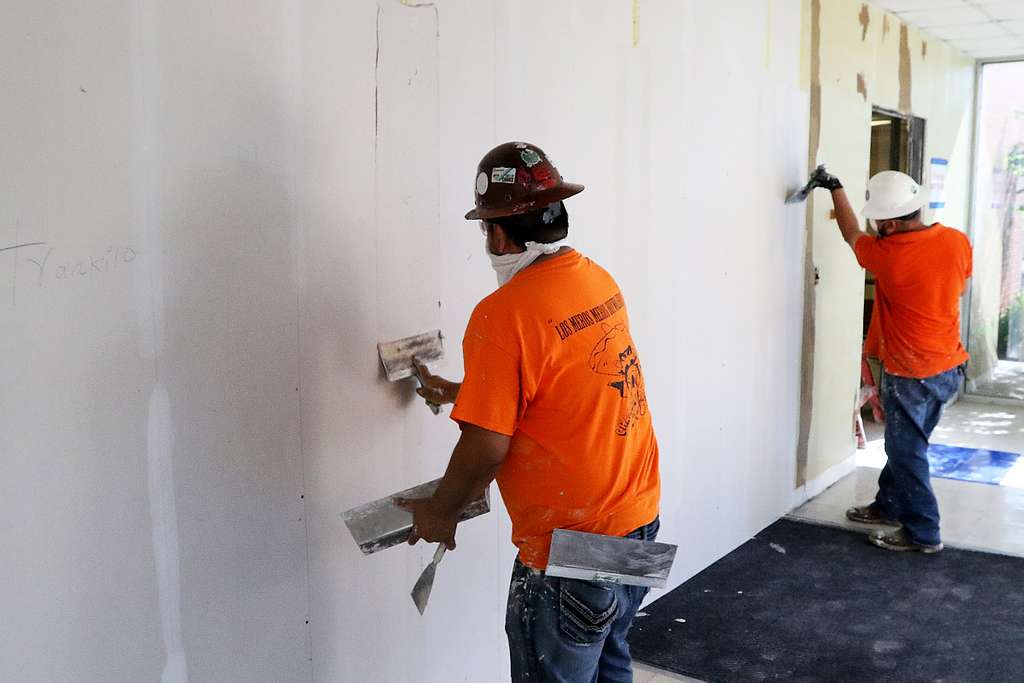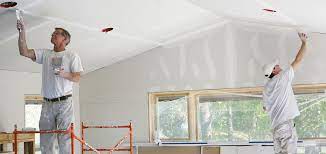The first thing you must know is screw spacing. Ask drywall professionals everybody has their own school of thought and could be correct in their own way you may agree or disagree. You can also take advice from local building codes.
How many screws are required per sheet of drywall can be determined by knowing what is maximum space allowed between each fastener or by knowing the thickness of the drywall?
You can use a minimum of 40 screws on the entire sheet. A sheet has 10 studs and if you use 4 screws in each stud it can make 40.
You must know the correct amount of screws to hand your drywall sheet otherwise this work will turn into a mess for you. It will become a budget enemy and time-consuming as well.
It can be determined the number of drywall screws by the spacing of studs in the wall and studs is generally 16 inches apart 4 by 8 sheet of drywall needed 28 screws.
Different sizes of sheets required a different number of screws.
Follow up on the basic definitions described below to have the perfect job done.
So what is Drywall?

Drywall is an adaptable building substance used to generate or protect walls and ceilings. There are many types and construction varieties available in the market. Mold-resistant, plasterboard, and VOC-absorbing are some common varieties.
Nowadays drywall has become the most ultimately basic finish stuff for inner walls. But back in history drywall was created after World War I, because most homeowners had lath and plaster for their wall stuff.
So to accomplish the demand for a rapid way to finish walls drywall was invented.
Importance of Drywall
On the internal material of domestic and business-purpose buildings, drywall is applied to serve fire-resistance and soundproofing services.
The methodology of screwing drywall into the framing skeleton, So to cover the gap the junctions between drywall panels are taped.
To patch the screw pits or holes and for achieving the supple transformation mud plays its role.
The finished look of your wall depends upon your desired final look so after the mud dries entirely it is time to sand it and to choose between a textured wall or a painted wall look.
6 Common Types of Drywall
The different types of drywall are generally modified by the color of the paper surrounding the drywall. The variant types are formulated by certain paper kinds to maximize the chemical level of the slurry.
1. Regular Drywall
it is also called a whiteboard,
Regular drywall, often called whiteboard, is the most common type used in ceilings and walls in homes and commercial projects. The most common thickness for residential use is ½ inch.
2. Mold-resistant Drywall
Mold-resistant drywall, often called green board, is made with a paper backing thicker than regular drywall and coated with wax for extra moisture resistance.
3. Plasterboard
Plasterboard, or blue board, is used as a base for plaster applications, much like the lath in lath and plaster walls. Plasterboard requires a thin coat or coats of plaster to be installed over the entire surface.
4. Soundproof Drywall
While all drywall has some soundproofing qualities, soundproof drywall adds additional wood fiber, gypsum, and polymers to increase the sound transmission class (STC) above that of regular drywall.
5. Fire-resistant Drywall
Specialized fire-resistant drywall is used in garages and basements, around equipment that might cause a fire. It contains fiberglass, which slows the progress of the fire and doesn’t burn as fast as regular gypsum. There are two types of fire-resistant drywall: Type X and Type C.
6. VOC-absorbing Drywall
A relatively new product, VOC-absorbing drywall captures chemicals and other volatile organic compounds and traps them within the drywall, making them inert.
These chemicals come from other building materials, as well as cleaning products we use every day. The drywall works even after being painted or covered with a light wall covering for up to 75 years.
Related Topic: What Are Deck Screws? Ultimate Guide
Edge
Place the screw about half an inch to 3/8 inch away from every edge.
Field
The surface apart from the edges is the field.
Lippage
When one title edge is higher than the adjoining title. Approximately 32 screws per sheet of drywall are installed horizontally. Building codes are different so check your screw pattern is up to code.
1. Determining Screw Needs
The number of screws per sheet of drywall can vary, depending on the size and thickness of the sheets that you’re using. Generally speaking, for smaller 1/2 inch thick boards, you’ll need 4-6 screws per board; for 3/8 inch thick boards, 8-10 screws per board; and for thicker 5/8 inch boards, 10-12 screws per board.
It’s important to note that the type of drywall screw used is also important – use coarse thread screws designed specifically for drywall, as these are stronger than standard wood or metal screws.
2. How to Calculate
Buy one screw per square foot of drywall installed. If your bedroom is 320 square feet divide 320 by 32 produces 10 so you need 10 sheets for your room.
3. Drywall screw Spacing for Wall Edges
In this process, if one edge protrudes farther than its neighbors will reduce the chances of accuracy in work. Using too many screws along the edges also creates problems for you.
4. Drywall screw Spacing for Wall Field
The Wall field is basically an inner area of the sheet. Drywall screw spacing for the wall field is 16 inches maximum and 12 inches minimum.
5. Drywall screws for Ceiling
When you hang drywall on the ceiling method will be the same as for walls. Experts advised less space between screws on the ceiling So you may need more screws. For 4 by 8 sheets of drywall, you need 36 screws. Increase the number with the increment of the size of the sheet.
6. Drywall screw Spacing for Ceilings
Horizontal ceiling placement produces too much stress on drywall so always use vertical ceiling placement. Ceiling field spacing could be a minimum of 7 inches and a maximum of 12 inches.
7. Best Drywall Screw Pattern
The screw pattern determines the screw spacing. You can set your distance as you want. Place your screws equally down in a line otherwise, they staggered. Some professionals think if the screw is staggered their performance increases others think differently.
Related Topic: How to Remove Rusted Screws
What to Do and Avoid
When Adhesive is Involved reduce Placement
The adhesive material can be used on studs of drywall screws. It increases the strength between the panels if we use it on the stud.
If you are not an expert in drywall work and you still use glue and once the glue dries and binds with the panel to the stud and you want to reinstall it you can not remove it without destroying the drywall.
If you Don’t use Enough Drywall screws
It can lead us to unimportant and expensive drywall repairs. Also, install screws properly.
Drywall Screw Pattern
Drywall screws should be installed every 12 inches. If you use 48 inches sheet you have 5 screws in each stud.
Drywall Nails Per Sheet
If you are using nails instead of screws the nails should be installed every 7 inches if you have a 48-inch wide sheet means that you have 8 nails in each stud.
Drywall Glue
If you decide to use glue. it is still required to use the same amount of screws or nails. The glue will increase the chances of accuracy in work.use glue where you find the problem.
Number of screws required
28 screws are required for 4 by 8 sheets of drywall. Wall studs in a modern home are 16 inches apart while in an older home, it is 12 inches apart. So you can use 32 screws for 4 by 8 sheets of drywall. If it is 4 by 12 it will take 48 screws.
Screws are required per sheet of Drywall a Ceiling
In this case, instead of screwing the sheet into the stud, you are going to screw them into the joists. The screw that goes into the joists should be spaced 16 inches apart and the other 12 inches apart.
Local Building Codes
Check local building codes and follow them. This code includes licenses of contractors, homeowner permits, and important inspections. If you fail in this ready for a fine in the form of cost.
Building codes are different in different locations. Building codes also depend on the way which is followed during construction. It could be state level or town level. Double-check your local building department.
If these protocols are not important in your community go ahead. Local building codes are also important to keep a focused eye on that before you work.
If building Codes Don’t Cover Drywall Hanging
If that is the case your drywall must be lightweight, fireproof, flexible, and moisture control to avoid any kind of damage.
Calculate the number of Drywall Sheets
By doing this you can save your money and you have zero waste. To calculate take the total square footage area and divide it by 32. It is for 4 by 8 sheets of drywall.
24 inches studs
Modern homes have 16 inches of space while others have 24 inches apart. in this case, 1 screw is required for attaching 4 by 8 sheets of drywall. It will take 21 screws.
Just attach your drywall like walls and ceiling. One thing you must consider is using thicker drywall. It is much stronger than thinner drywall which sags and breaks.
Drywall screws for wall
You can take help by considering the size of your drywall panels to calculate the number of needed screws.
When studs are 16 inches apart.
- Use 28 screws for 4 by8 sheet
- Use 36 screws for 4 by 12 sheets.
When 12 inches apart
- Use 32 screws for 4 by 8 sheets.
- Use 48 screws for 4 by 12 sheets.
Other Related Topics:
Other Drywall Installation Tips
In addition to using the correct number of screws per sheet, here are a few other tips for successful drywall installation:
- Use dust masks and safety goggles when cutting drywall sheets.
- Make sure to use a level when hanging the boards – crooked boards will be difficult to hide once they’re painted or wallpapered.
- Use drywall tape to cover up the seams between sheets – this will provide a smooth, finished look when you’re all done.
- Apply joint compound and let it dry before sanding the walls for a smoother finish.
Conclusion
Drywall is a great way to add a professional touch to any room in your home. To make sure your drywall installation is done correctly, use the right number of screws per sheet and follow all safety precautions.
FAQs
Q. What type of screws should I use for drywall?
For the best results, use coarse thread screws designed specifically for drywall – these are stronger than standard wood or metal screws and will provide a more secure hold.
Q. Is it important to pre-drill holes before installing drywall screws?
Yes – pre-drilling holes will help prevent the drywall board from cracking or splitting when you drive in the screws.
Q. How thick should my joint compound be?
When applying joint compound, make sure it isn’t too thin or too thick – a thickness of about 1/8″ should be optimal for covering the seams between sheets of drywall.


Very informative article post.Really looking forward to read more. Great.